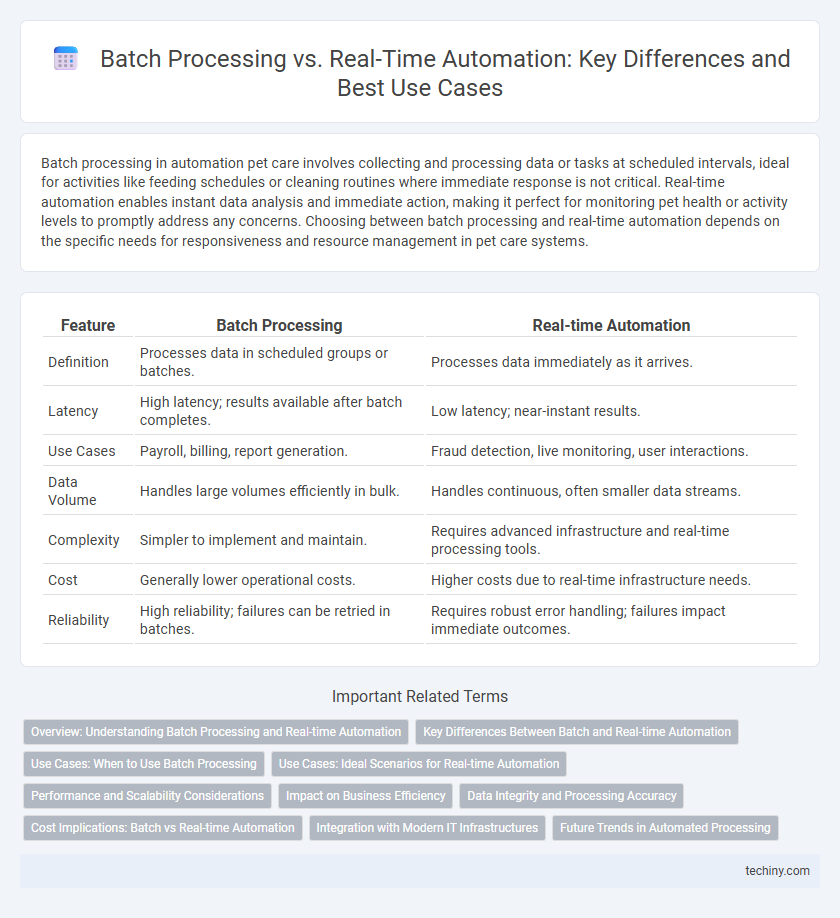Batch processing in automation pet care involves collecting and processing data or tasks at scheduled intervals, ideal for activities like feeding schedules or cleaning routines where immediate response is not critical. Real-time automation enables instant data analysis and immediate action, making it perfect for monitoring pet health or activity levels to promptly address any concerns. Choosing between batch processing and real-time automation depends on the specific needs for responsiveness and resource management in pet care systems.
Table of Comparison
| Feature | Batch Processing | Real-time Automation |
|---|---|---|
| Definition | Processes data in scheduled groups or batches. | Processes data immediately as it arrives. |
| Latency | High latency; results available after batch completes. | Low latency; near-instant results. |
| Use Cases | Payroll, billing, report generation. | Fraud detection, live monitoring, user interactions. |
| Data Volume | Handles large volumes efficiently in bulk. | Handles continuous, often smaller data streams. |
| Complexity | Simpler to implement and maintain. | Requires advanced infrastructure and real-time processing tools. |
| Cost | Generally lower operational costs. | Higher costs due to real-time infrastructure needs. |
| Reliability | High reliability; failures can be retried in batches. | Requires robust error handling; failures impact immediate outcomes. |
Overview: Understanding Batch Processing and Real-time Automation
Batch processing automates tasks by collecting data and executing them in groups at scheduled intervals, optimizing efficiency for large-volume operations with minimal immediate interaction. Real-time automation processes data instantly, enabling immediate responses and continuous workflow without delay, essential for time-sensitive applications in finance, healthcare, and customer service. Understanding the distinctions informs system design and operational strategies, balancing throughput and responsiveness in automation solutions.
Key Differences Between Batch and Real-time Automation
Batch processing automates tasks by grouping data into large sets for scheduled execution, optimizing resource use but introducing latency. Real-time automation processes data instantly as events occur, enabling immediate responses critical for time-sensitive applications. Key differences include processing speed, timing, and suitability, with batch suited for high-volume, non-urgent tasks, and real-time ideal for dynamic environments requiring continuous updates.
Use Cases: When to Use Batch Processing
Batch processing is ideal for handling large volumes of data where real-time response is not critical, such as payroll calculations, billing statements, and end-of-day financial reporting. It enhances efficiency by scheduling tasks during off-peak hours, reducing system load and resource contention. Use batch processing when processing times can be delayed without impacting business operations or customer experience.
Use Cases: Ideal Scenarios for Real-time Automation
Real-time automation excels in scenarios requiring immediate data processing and instant decision-making, such as fraud detection in financial transactions, dynamic pricing in e-commerce, and patient monitoring in healthcare systems. Industries relying on rapid response and continuous data streams benefit from real-time automation to enhance customer experience and operational efficiency. This approach reduces latency, enabling systems to adapt promptly to changing conditions and maintain optimal performance.
Performance and Scalability Considerations
Batch processing handles large volumes of data by processing it in scheduled groups, optimizing resource use and enabling high throughput for complex tasks. Real-time automation prioritizes immediate data processing to ensure low latency and rapid response, which may demand more scalable and robust infrastructure to handle continuous data streams. Performance in batch systems excels in predictable workloads, while real-time automation requires elastic scalability to maintain responsiveness under fluctuating demand.
Impact on Business Efficiency
Batch processing consolidates large volumes of data, enabling streamlined operations and cost efficiency during off-peak hours, which benefits businesses with predictable, high-volume workloads. Real-time automation processes data instantaneously, enhancing responsiveness and decision-making speed, crucial for dynamic environments requiring immediate insights. Businesses leveraging real-time automation experience improved customer satisfaction and faster adaptation to market changes, while batch processing remains valuable for reducing system strain and operational costs.
Data Integrity and Processing Accuracy
Batch processing ensures data integrity by handling large volumes of data in controlled, scheduled intervals, reducing the risk of errors through systematic validation and reconciliation processes. Real-time automation enhances processing accuracy by delivering instant updates and continuous monitoring, minimizing latency and enabling immediate error detection and correction. Both approaches optimize data accuracy, with batch processing suited for comprehensive, periodic analysis and real-time automation ideal for dynamic, time-sensitive applications.
Cost Implications: Batch vs Real-time Automation
Batch processing automation typically incurs lower operational costs due to scheduled execution and resource optimization, making it ideal for handling large volumes of data with less frequent updates. Real-time automation demands higher investment in infrastructure and continuous monitoring to ensure immediate processing and response, leading to increased expenses in bandwidth, computing power, and maintenance. Businesses must weigh cost trade-offs against latency requirements to determine the most cost-effective solution between batch and real-time automation.
Integration with Modern IT Infrastructures
Batch processing systems excel in handling large volumes of data with scheduled execution, making them ideal for legacy IT infrastructures where predictable workloads dominate. Real-time automation integrates seamlessly with modern IT ecosystems through APIs, cloud platforms, and microservices architectures, enabling instantaneous data processing and immediate response to dynamic business events. Enterprises leveraging real-time automation benefit from enhanced scalability, flexibility, and continuous data synchronization across distributed systems.
Future Trends in Automated Processing
Future trends in automated processing emphasize the integration of real-time automation powered by artificial intelligence and edge computing, enabling instantaneous data analysis and decision-making. Batch processing continues to evolve with enhanced scalability and cloud-based solutions, optimizing large-scale data workflows for cost-efficiency. The convergence of these approaches drives hybrid automation models that balance latency requirements and processing volume for diverse industry applications.
Batch Processing vs Real-time Automation Infographic

 techiny.com
techiny.com